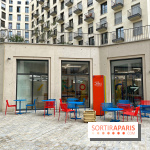In the Rosa Parks district, located in the 19th arrondissement, a real island has emerged in just a few years. Previously, this entire space was a vast, almost unoccupied industrial wasteland with real potential. In 2016, the Fertile Islet project won the "Reinvent Paris" competition and successfully made this 1.3-hectare plot of land the first zero-carbon neighborhood in the capital. Very accessible, it is located a stone's throw from the RER E, the metro 7 and the T3b tramway, and will soon be able to take advantage of a third place on the piece of the Petite Ceinture that adjoins it.
But what can you find in this unique neighborhood in Paris? There is plenty of room to live and settle down, whether as a family or alone, thanks to the construction of 126 mixed housing units (including 16 social housing units), 164 for students and 150 for young workers. To welcome tourists or travelers, a 129-room hotel and a 228-bed youth hostel make the neighborhood very active. We had already discovered this UCPA sports hostel, which offers an exceptional range of climbing, fitness, snowshoe sports and rooms at very affordable prices. All the inhabitants of the district can take advantage of this complex as well as the bar-restaurant, open to all and a real place of life.



 Sport Hostel, UCPA's first sports youth hostel in Paris
Sport Hostel, UCPA's first sports youth hostel in Paris
UCPA has opened a unique place between a youth hostel and a sports multiplex in Paris, in the 19th district. The opportunity for travelers to sleep and do sports in the same place, in a friendly environment. [Read more]
L'Îlot fertile also houses six shops, offices for businesses, a start-up incubator with a coworking space and soon a logistics base distributing parcels to be delivered in the neighborhood by electric bicycle. 3,800 square meters of green space allow residents to enjoy nature, with orchards and vegetable gardens available. Even the roofs are bio-solar and vegetated, and the terraces are planted to provide a habitat for the flora and fauna of the Ile-de-France, with insect hotels, bat shelters, dry stones for lizards and bird nesting boxes.
With regard to the zero-carbon objective, 10,000 m2 of local cut stone was used for the facades or low-carbon concrete, which allows for low emissions. Most of the materials were reused, and the waste from the construction site could be reused afterwards. The buildings were designed from the outset to limit energy needs and to produce some of it themselves.















